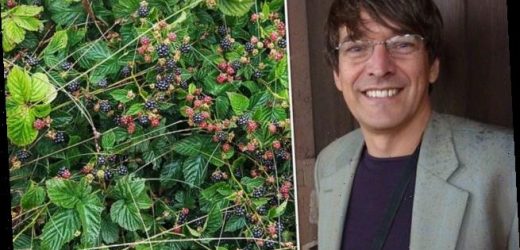How BRAMBLES can help solve complex cold cases: Forensic botanist reveals how he can use plant roots to deduce a time frame for a body being dumped in as little as 30 minutes
- Dr Mark Spencer curates the Natural History Museum botanical collections
- He also works as a forensic botanist, using plant fragments to help solve crimes
- Revealed on BBC’s The Life Scientific how brambles are particularly helpful
- Said he can use the stem and the root to determine the year someone died
Dr Mark Spencer is a curator of the botanical collections at the Natural History Museum and works as a forensic botanist
A forensic botanist has revealed how he uses the clues left by mother nature to help police solve complex cold cases.
Dr Mark Spencer is a curator of the botanical collections at the Natural History Museum in London and is intimately acquainted with British flora past and present.
Alongside his day job he works as a forensic botanist, using his expertise to help police determine where and when a crime might have taken place.
Speaking on BBC R4’s The Life Scientific, Dr Spencer explained one of his favourite plants to use in these scenarios are brambles, which can be ‘very, very useful’ when pinpointing a time frame due to the regimented way in which they grow.
He has described them as ‘vegetable calendars’ that can be used to determine the year in which a body most likely ended up at the crime scene in as little as 30 minutes, saving investigating officers valuable time and money.
‘Each different plant has got a different way of growing, a different way of behaving and so you have to learn and understand that,’ Dr Spencer explained.
‘And that’s why my 40+ years of studying plants in Britain helps because I’m familiar with their ways of being.’
A ‘pet plant’ in these scenarios are brambles, which can be ‘very, very useful’ when it comes to pinpointing a time frame due to the regimented way in which it grows. Stock image
Dr Spencer helps solve the most serious types of crime, including murder and sexual assault.
He explained how once a body or the remains of a body is discovered, nearby plant life can hold important clues as to when the body ended up at the scene.
How brambles can help solve thorny crimes
Brambles might look messy but their way of growing is ‘very, very neat’, explained Dr Spencer, allowing them to work as ‘vegetable calendars’ that can be consulted to determine their age.
‘Each year, each individual rootstock, will produce one or two vigorously growing stems. Those stems, their primary job in their first year is to get bigger, grow leaves, photosynthesise and get energy.
‘They then go to sleep through that winter, following spring they flower, then fruit and become nice blackberries.
‘At the same time, a new stem is coming through. After their second year, in most cases, bramble stems start to die away because they are overtopped by other stems.
‘So by looking at the stems overarching the person and the rootstock, I can essentially count the number of stems, have a bit of an estimate [as to how long it’s been growing].’
‘Usually it’s a matter of the person’s body is lying there, vegetation grows over them, and is connected with them,’ he continued.
‘It can be sometimes, for example, a root growing through a skeletal remain. And so, root rings, similar to dendrochronology [the dating of tree rings] can be used to estimate time frames.’
In the case of brambles, they might grow in thickets that look ‘messy and chaotic’ but they are in fact ‘very, very tidy plants’ with a specific method of growing.
He continued: ‘Each year, each individual rootstock, will produce one or two vigorously growing stems. Those stems, their primary job in their first year is to get bigger, grow leaves, photosynthesise and get energy.
‘They then go to sleep through that winter, following spring they flower, then fruit and become nice blackberries.
‘At the same time, a new stem is coming through. After their second year, in most cases, bramble stems start to die away because they are overtopped by other stems.
‘So by looking at the stems overarching the person and the rootstock, I can essentially count the number of stems, have a bit of an estimate and usually be able to come up with a scenario where I can tell a police team, “you’re looking at 7/8 years ago” or “12/13 years ago” as a good estimate.’
This is particularly useful in the early stages of an investigation, and when police do not have any identification for the body.
Dr Spencer added: ‘So if I can say within half and hour or so, “you need to look at the missing person records from 2012” that can be very cost effective and really help speed up the investigation.’
How vegetation can connect a suspect to a crime scene
Dr Spencer also uses his skills to help connect victims and suspects to crime scenes.
He explained: ‘The reality is if you have committed a crime, wherever you go in the world, you pick up traces of where you have been.
‘If you walk into a woods after committing a serious crime, you will pick up soil. In that soil there may well be seeds, there will be pollen, fungal spores, bits of foliage.
‘That trace evidence is very, very useful because you will take that back to your home. It might attach to your car wheel arch, or a spade, and if I’m provided with that material I can look at it, and, sometimes along with other specialists, identify that biological trace evidence. Then potentially use that to link to a crime scene.
‘We have incredibly rich mapping of our wild plants. So if I am presented with an exhibit from a suspect’s spade, and it has a fragment of a particular type of plant, once I have identified it using these dusty old museum collections, we can then look at the national mapping scheme and help focus on where that person may have been.’
Source: Read Full Article




